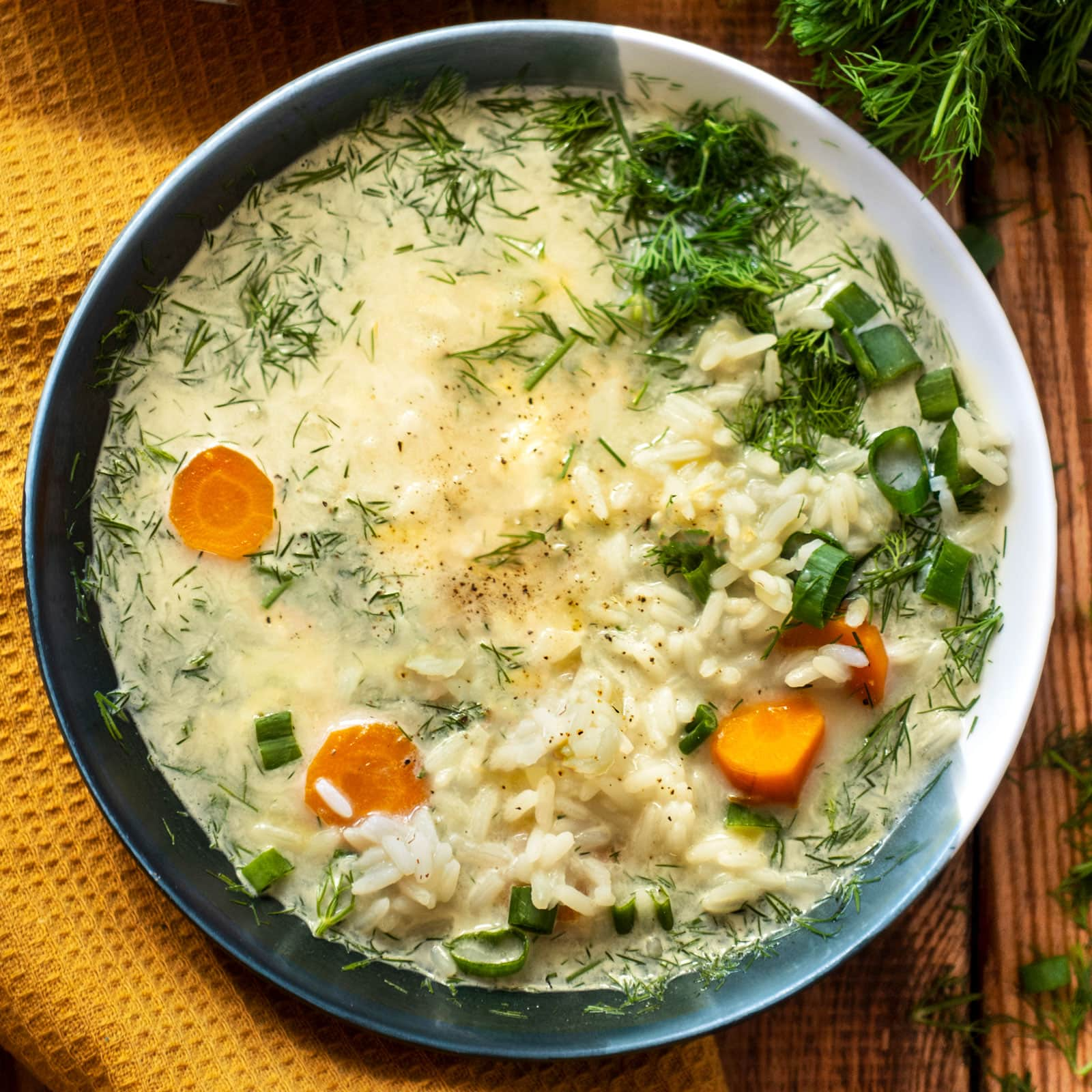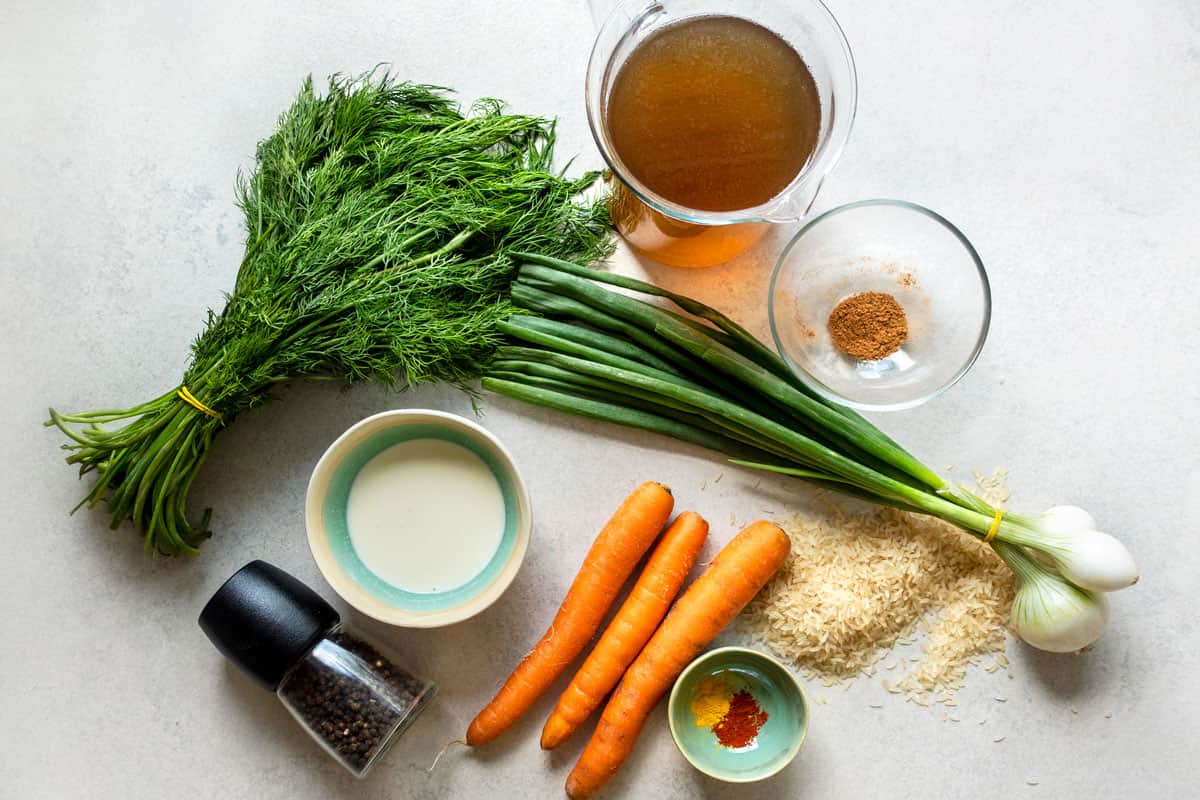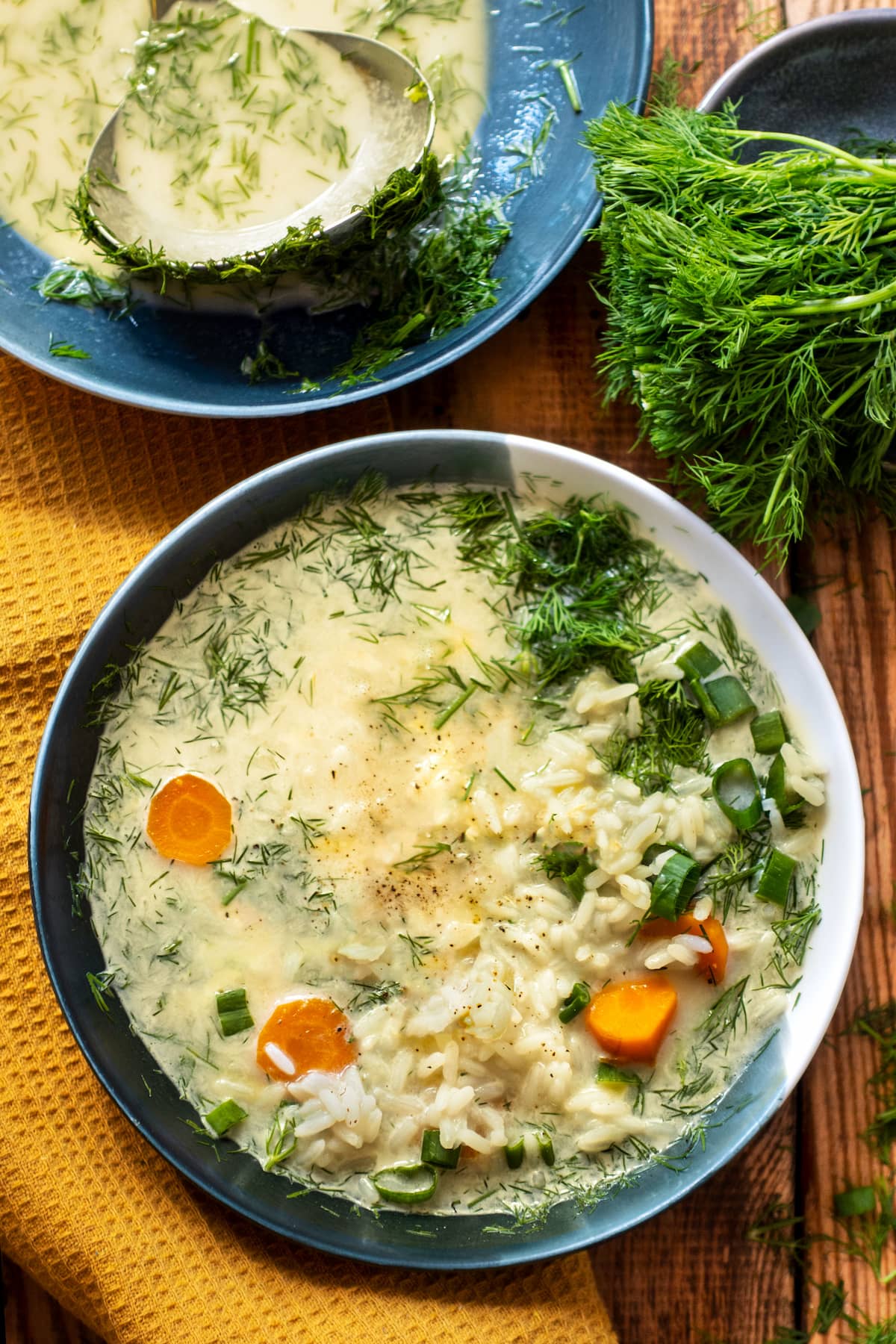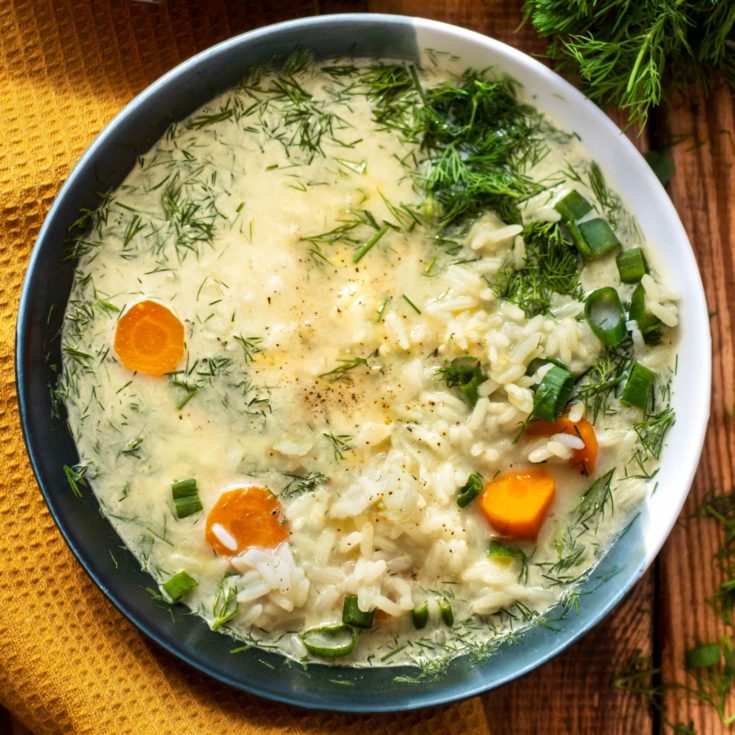Zupa Koperkowa z Ryżem
Koperkowa: Polish Dill Soup with Rice
How to pronounce it?
zoo-pah coper-cova
‘Play’ to hear:

In most Western cuisines, dill isn’t something you generally use in large quantities. More often than not, it’s only humbly peeking at us from the plate – acting as a mere garnish.
And that’s what makes this classic ‘Zupa Koperkowa’ so special. Here, our fragrant, feathery herb really takes centre stage. It takes less than 30 minutes to turn it into a delightful, fresh-tasting soup.
For the full list of ingredients & detailed instructions, please see the recipe card at the end of this post. But before you scroll, there’s important stuff to know below.
Do you need any special ingredients or equipment to make this Polish DILL SOUP?
Most of the ingredients for this soup should be easily available in any major supermarket.

The most important ingredient is fresh dill – and a lot of it. You’ll need a large (approx. 3.5 oz, 100 g) bunch – that’s roughly its size at my local produce stalls.
If you’re shopping at a supermarket, do be mindful of the size and weight, as these larger stores tend to sell much smaller bunches.
I would like to encourage you to use homemade stock, if you get a chance. It’s much more flavourful than a store-bought product from a carton.
Equipment-wise, you’ll need a heavy-bottomed cooking pot, sized at 3 quarts (approx. 3 litres) or more. If yours has no heavy bottom, follow the initial steps (3 through 5) using a skillet/frying pan, then move its contents into a cooking pot.
How should you serve this ‘Koperkowa’ Soup?
Dill Soup is traditionally served as a starter, before the main meal.
You could also enjoy it on it’s own, for lunch or as a lighter dinner. To make it more filling, you could add some fresh bread or a piece of baguette on the side.
Can you make this Polish DILL SOUP another way?
Yes. If you’re not a rice enthusiast, you could also try it with:
- potatoes (here’s Dill Soup with Potatoes recipe)
- pasta, egg noodles or drop noodles
- tiny meatballs (‘pulpety’ in Polish), most commonly made of poultry meat (e.g. turkey)
- boiled egg, halved or quartered
- millet or barley
Feel free to experiment with different stocks and broths as a base. You could also add more veggies, such as leeks, celery stalks, parsley root…
I haven’t tried making this recipe in a crock pot, but I’m sure it can be done.
What diets is this ‘Zupa Koperkowa’ suitable for?
This recipe is suitable for a traditional diet. To make it vegetarian-friendly, use a vegetable stock instead of a meat-based one.
How long can you keep this Polish Dill Soup in the fridge?
‘Koperkowa’ tastes best when served hot. Once served, ideally you should eat it within 3-4 hours.
To store any leftovers, refrigerate the soup in a container with a lid. It can be refrigerated for up to 3 days.
Can I freeze this ‘Koperkowa’ Soup?
Yes, this recipe can be frozen. As soon as the soup is completely cooled, move it into a freezer-friendly container. Remember to label the box with a description and a date. Aim to consume within 3 months.
How do I reheat this SOUP?
From chilled: Place the soup in a microwave-friendly container and cover loosely with a lid. Heat for 4 to 7 minutes until hot throughout.
From frozen: Allow the soup to thaw overnight. Heat in the microwave (covered) for 3 to 5 minutes, then open and stir. Careful, it’s going to be hot! Next, continue cooking for another 5 minutes until hot throughout.
Alternatively, you can reheat the soup on the stove. Bring it to a boil, reduce the heat and cook for another 2-3 minutes on medium-low.

Koperkowa: Polish Dill Soup with Rice

‘Zupa Koperkowa’ is a Polish-style Dill Soup.
It takes less than 30 minutes to turn a bunch of dill into a delightful, fresh-tasting soup.
Ingredients
- 3 medium carrots (8 oz, 230 g)
- 1 spring onion, with large bulbs
- 1 tablespoon butter
- 32-35 oz (0.9 -1 litre) stock, vegetable or meat-based, ideally homemade
- 1/2 cup (100 g) white rice, uncooked
- ½ teaspoon salt
- 4 tablespoons heavy cream, 30% or 36% fat
- 1 large bunch (3.5 oz, 100 g) fresh dill
- ½ teaspoon nutmeg, ground or grated
- Salt, for seasoning
- Black pepper, freshly ground, for seasoning
- Pinch of turmeric, for colour
- Pinch of mild paprika powder, for seasoning
Instructions
- Peel the carrots.
- Slice carrots and onions (separated from the spring onion) into thin rounds. Thinly slice the green part as well, and set aside.
- Place the cooking pot (with a thicker base) on the stove. If you don’t own one, it’s better to use a frying pan / skillet instead. Set the heat on medium-low.
- Melt a tablespoon of butter, add carrot and onion rounds with a tiny pinch of salt. Fry, stirring occasionally, until the onion turns translucent.
- Add spring onion greens and fry together for an additional 2 minutes.
- Pour the stock in, bring to a near-boil, then reduce the heat to medium-low.
- Add in uncooked rice and half a teaspoon of salt.
- Partially cover the pot with a lid and cook for 15 minutes, until the rice softens.
- Pour one cup of hot soup into a bowl (avoiding the rice), and add in 4 tablespoons of heavy cream. Blend together with a fork or spoon, and return to the pot.
- Chop fresh dill finely, leaving some leaves aside for garnish.
- Add chopped dill and sliced spring onion greens into the soup, stir them in.
- Season the soup with half a teaspoon of nutmeg, a pinch of turmeric and mild paprika powder, as well as a generous pinch of freshly ground black pepper.
- Stir and cook together for a further 3-4 minutes, letting the flavours combine.
- Have a taste. Does it need more salt or pepper? If so, season the soup a bit more.
- Garnish with leftover chopped dill and serve.
Nutrition Information:
Yield:
4Serving Size:
1Amount Per Serving: Calories: 561Total Fat: 10gSaturated Fat: 5gTrans Fat: 0gUnsaturated Fat: 4gCholesterol: 40mgSodium: 833mgCarbohydrates: 91gFiber: 29gSugar: 21gProtein: 26g
Polonist is reader-supported. When you buy through links on our site, we may earn a small affiliate commission. Learn more
Recipe Information
Filed under:
Alternative traditional/regional names:
Also known / Misspelt internationally as:
Polish Dill Soup
Tested by:
First published on:
Recipe by / Adapted from:
Story by:
Bibliography / References: